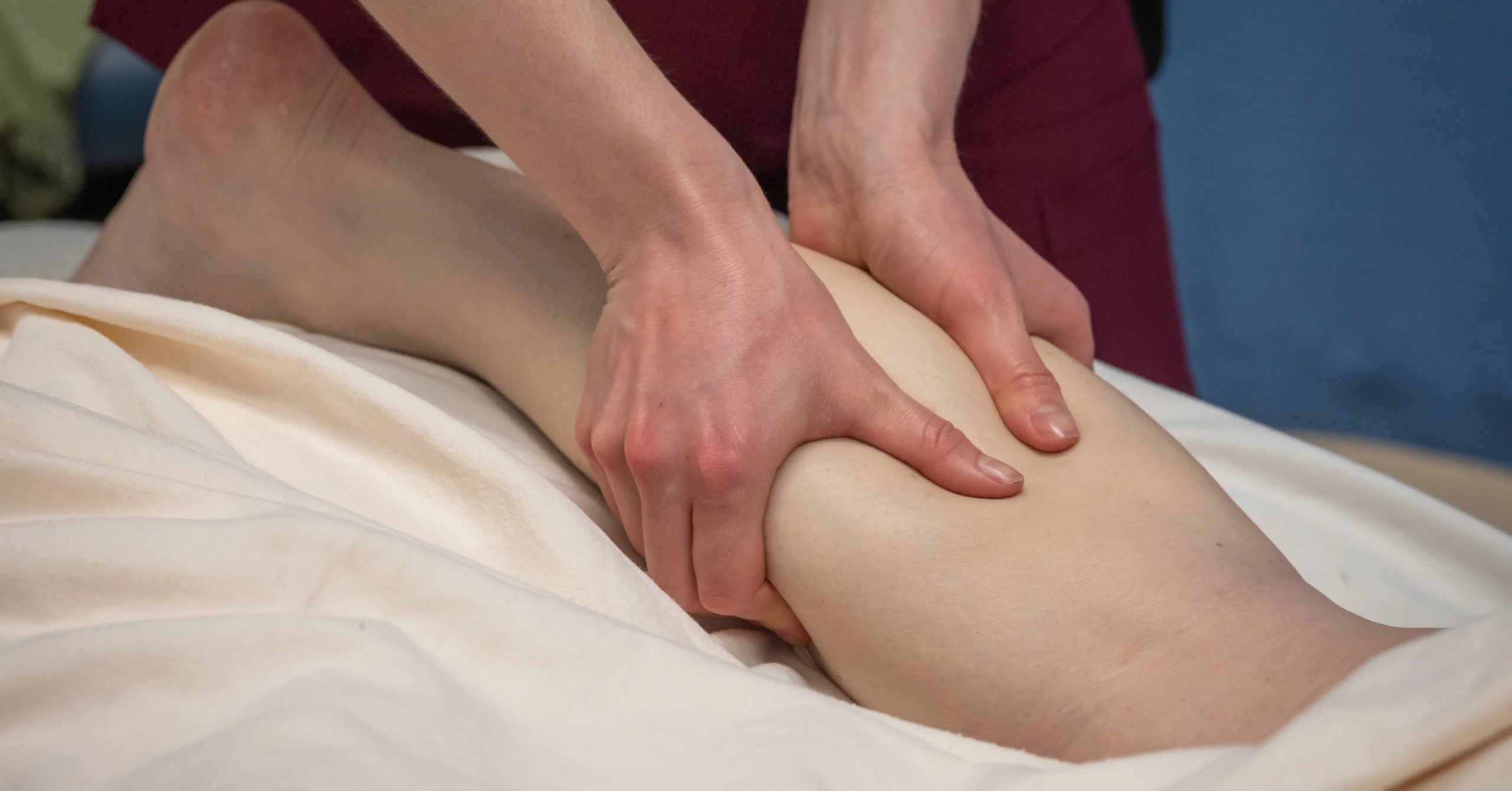According to the massage therapy and acupuncture students, the benefits of these practices are endless, especially at MacEwan University
If you’re a university student, odds are that you’ve been stressed before. There can be comfort in knowing that everyone else is experiencing the same exact things, whether it’s exam anxiety, stress from an overwhelming workload, depression from personal relationships, or burnout from pushing yourself too hard.
At MacEwan, acupuncture and massage are just some of the ways to start to manage these stressors. The acupuncture and massage therapy diploma programs offered on campus set students up for a successful future with a myriad of career options. These packed and busy programs are a vital addition to campus, with our very own teaching clinics in the Robbins Building. Through these two programs, students and the public are able to access massage therapy and acupuncture sessions for a low cost, all while helping their fellow students complete their diplomas.
“Massage has some pretty significant research on how it reduces stress and anxiety, and promotes just an overall sense of wellbeing,” says Jeff Moggach, an associate professor and massage therapy teaching clinic supervisor.
And although these services are promoted to MacEwan students, they also welcome the downtown community as well.
Acupuncture
For Jason Kossowan, a third-year acupuncture student, the program isn’t just a learning opportunity, it’s a step into a larger future as an acupuncturist.
Kossowan has always had a passion for Chinese medicine and helping people. “This had always been on my radar,” he says. “I wanted to go into medicine when I was in high school, but back in the mid-90s there wasn’t really an acupuncture program to be had.” Now, it’s a lot more common.
Acupuncture falls under the scope of traditional Chinese medicine, which includes other elements like herbal health practices. Kossowan explains that this has always been a part of his life. In line with Chinese medicine, he has a history of Chinese martial arts in tai chi and kung fu, which is what initially piqued his interest in the industry. “They kind of share the same space,” he says. “So, when I looked at the calendar and saw all the courses and all the stuff I was nerding out on anyways at home, I just decided, ‘Hey, this is a good fit!’”
When he chose MacEwan, there were many elements that stood out to him, from the program’s good reputation to its ability to provide students with a broad spectrum of learning within their diploma.
The three-year diploma is the only public post-secondary program in the province, which allows graduates to continue in the industry after completing the program to write their licencing exam and become a fully licenced acupuncturist.
“Students are notoriously overthinking and overstressed, and acupuncture does a really good job of treating both of those.”
Jason Kossowan, third-year acupuncture student
Since the acupuncture space on campus is just a teaching clinic, it’s filled with students of all three years, as well as sessional instructors, who are licensed acupuncturists, to oversee the sessions.
Since this is one of MacEwan’s most expensive programs, the students are actually paying in tuition to be able to do the services, rather than being paid by patients for their labour. Yet, they do earn credits towards their diploma, and get realistic, hands-on experience without having to leave campus.
Students with 500 completed clinical hours are eligible to write the licensing exam post-graduation. But according to Kossowan, it’s not that difficult of a process. “We get a crew in here every Friday, and we do our time where with clinical hours and learn things in the clinic,” he says. “We do that for about a year and a half.”
Once the exam is passed, the options are endless. “Part of the appeal to the profession is that there’s a few different ways you can spin it,” Kossowan reveals. “You can open your own clinic or become a subcontractor and work in someone else’s clinic, [you can] be either a physiotherapist or a chiropractor… there’s lots of ways to kind of flex how you do it.”
But for now, the students are able to put all of their focus into the teaching clinic, working one-on-one with patients and learning from the pros in a hands-on approach — literally. “Usually the first clinical appointment is just a meet-and-greet and you doing your intake,” Kossowan explains. “So, we’re trained on how to do the diagnostic intake and ask questions.”
Every follow-up session is a 90-minute session with a student practitioner patients are teamed up with for the semester. The acupuncture student will get to know their medical history, stressors and everyday health concerns like diet and lifestyle, and even keep track of which treatments work best for them over the course of a few months.
Everyone comes in for a different reason, but as students, there’s one common problem that’s seen by the acupuncturists. One of the biggest benefits of acupuncture for students? “Stress relief,” Kossowan says. “Students are notoriously overthinking and overstressed, and acupuncture does a really good job of treating both of those.”
The options for treatment range, but overall, “we can help them regulate diet recommendations and pain management, anxiety, and depression, in areas where people are looking for an alternative for biomedical [options],” he adds. “We’re looking at it from a much larger, holistic picture.”
And for those skeptical students who are wanting to try it out, there’s nothing to fear. “Our first goal is to get everybody comfortable on the table and into a safe space where they can relax,” Kossowan says.
As students themselves, the acupuncturists are learning as they go. They can use the patients as a way to enhance their learning while helping someone out who may be struggling. “There is a certain amount of patience that’s required by our patients — no pun intended,” he adds. “We are on a learning curve and we’re trying things we haven’t tried before on a patient.” But, that’s all just a part of the learning process.
It’s not a scary or unsafe space. In fact, it’s one of the more welcoming acupuncture clinics I’ve ever visited. “Most people… because they haven’t experienced it, they don’t know what to expect, but the biggest takeaway from most people is a ‘chill vibe’ going out the door.”
The ultimate goal of the teaching clinic works as a two-way street. Students get the opportunity to learn and practice in real time, while patients get a discounted service that can make a real difference. And in the end, that’s exactly what Kossowan loves to do. He enjoys helping people who are “getting people out of pain and… chronic conditions, or relieving any kind of acute symptoms they have, whether it’s migraines or carpal tunnel syndrome, or frozen shoulder,” he says. “Those are all things that people don’t want to live with, and shouldn’t have to live with.”
Massage therapy
Hannah Cruthers, a second-year massage therapy student, has always had a passion for the industry as well.
“I grew up playing soccer since age four,” she says. “I have suffered my fair share of ankle and back injuries, so I grew up alongside physio, chiro, acupuncture, and massage pretty much my whole life.”
After her high school graduation, Cruthers decided to attend the U of A for kinesiology. She knew that she wanted to be in healthcare, but quickly realized that physio and kinesiology just weren’t fitting for her long-term goals.
After taking a gap year and attending NAIT for denturist technology, she still didn’t know what specialty she wanted to pursue. Following through with her background in anatomy, she started up again at MacEwan and chose the massage therapy diploma. “I’ve always wanted to work in health care and wanted to help people… and I haven’t looked back since. I’ve absolutely loved the program, as stressful and busy as it is,” she says. “I’ve never been so motivated to learn. Not only is it going to help someone else, but I’ve learned so much about myself.”
The two-year diploma program consists of six semesters in which students take six to eight courses in the winter and three in the spring. The classes range from anatomy, physiology, techniques, and more. There’s a clinical once a week, in which students get to work hands-on in the teaching clinic with patients. “It’s very fast, but for me, I really like it,” Cruthers says. “It’s nice to just get in, get out, and then get working.”
“It’s a nice hour that you can dedicate to just yourself, work on your breathing and eliminating the stress, and focus on taking care of your muscles.”
Hannah Cruthers, second-year massage therapy student.
Once students have completed the 2,200 clinical hours during their diploma, they’re able to go out and work right away without the stress of an exam or further schooling.
After graduation, the employment options are really diverse. Cruthers reveals that the program gives you a taste of the different professions, like sports massage, relaxation, prenatal, and therapeutic. It’s a versatile industry. “If you don’t like the area you’re working in, it’s so easy to go and find something else that suits your fancy,” she says.
And for students specifically, Cruthers believes that massage is one of the best ways to decompress. “Our muscles have memory, and they can carry that stress and trauma in it,” she says. “Massage is super beneficial, whether it’s from relaxation to decreasing stress and anxiety.”
Max value, minor stress
The teaching clinic is undoubtedly one of the most affordable and professional spots to get a massage in the city. It has the convenience of being on campus and having fellow students who have a real passion for what they’re doing. “It’s huge for students,” Cruthers says. “It’s a nice hour that you can dedicate to just yourself, work on your breathing and eliminating the stress, and focus on taking care of your muscles.”
The acupuncture clinic is located in room 9-302 in the Robbins Health Learning Centre. Patients are able to access acupuncture, cupping, gua sha, acupressure, moxibustion, and other specialty services tailored to their health concerns. The fee for each 90-minute session is $15, which covers the cost of supplies.
The massage therapy appointments take place in room 9-310A in Robbins. Sessions offer massage therapy for all types of pain, stress, and health conditions. These foci include upper body work, pregnancy, infant and adolescent massages, general wellness, full-body massage and injury care, and postural work. The 60-minute sessions are $20 per treatment, but there’s options to expand to longer appointments.
Appointments for both programs occur once a week for an entire semester, and it is preferred that patients attend at least five consecutive appointments to have a continuous plan of work with their acupuncture or massage therapist.
For current students in other programs, Moggach wants them to know how much they can benefit from stopping by for an appointment. “I think a lot of students don’t even realize that we’re here. Especially during exam time and stressful periods,” he says. “Not only are they supporting a fellow MacEwan student, but they’re also getting the benefits of massage, so it’s kind of a win-win.”
For students who are considering trying these services, both Kossowan and Cruthers want people to know just how safe the clinics really are. “You’re undressed on a table showing your vulnerable self. It can be a lot for some people, especially if you have pain or trauma,” Cruthers says. “[But], don’t be shy. Come on in. Try it out.”
For the programs’ students, they’re able to obtain the essential skills necessary for entering the workforce post-grad. And for patients, it gives them the opportunity to manage their health in a cost-effective way to see a real difference. “When it works, it’s really mind blowing,” Kossowan adds. “It’s very gratifying.”
Photo credits to Sam Poier





0 Comments